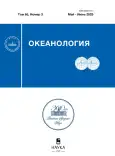GEOLOGICAL STRUCTURE AND PROSPECTS OF OIL AND GASBEARING AT THE CONTINENTAL MARGIN OF TANZANIA
- Autores: Zabanbark A.1, Lobkovsky L.I.1
-
Afiliações:
- Shirshov Institute of Oceanology RAS
- Edição: Volume 65, Nº 3 (2025)
- Páginas: 512-523
- Seção: Морская геология
- URL: https://bakhtiniada.ru/0030-1574/article/view/306130
- DOI: https://doi.org/10.31857/S0030157425030111
- EDN: https://elibrary.ru/gwygjj
- ID: 306130
Citar
Resumo
Sobre autores
A. Zabanbark
Shirshov Institute of Oceanology RAS
Email: azaban@ocean.ru
Moscow, Russia
L. Lobkovsky
Shirshov Institute of Oceanology RAS
Email: llobkovsky@ocean.ru
Moscow, Russia
Bibliografia
- Забанбарк А., Конюхов А.И., Лобковский Л.И. Формирование газовых скоплений на Восточно- Африканской континентальной окраине // Океанология. 2023. Т. 63. № 3. С. 475–481.
- APT to begin seismic work in Ruvuma PSA, Tanzania // Oil and Gas J. 2020. V. 118. P. 7.
- Benatus N., Mvile B., Kiswaka E. et al. Cretaceous-Quaternary seismic stratigraphy of the–Tanga offshore basin in Tanzania and its petroleum potential // J. Petro. Exploration and Produc. Technology. 2022. № 12. P. 279–298.
- Brownfield M.E. Assessment of undiscovered hydrocarbon resources of the Tanzania coastal province, east Africa. Digital data series 69-GG, U.S. Department of the Interior. U.S. Geological Survey, Reston, Virginia. 2016. 15 p.
- Catuneanu O., Wopfner H., Eriksson P.G. et al. The Karoo basins of South-Central Africa // J. African Earth Sciences. 2005. № 43. P. 211–253.
- Cope M. Tanzania’s Mafia deepwater basin // Oil and Gas J. 2000. V. 98. № 33. P. 40–49.
- Davidson I., Steel I. Geology and hydrocarbon potential of the East African continental margin: a review // Petroleum Geoscience. 2018. V. 24. Iss. 1. P. 57–91.
- Francis M., Milne G., Kornphil K. et al. Petroleum systems of the deepwater Mozambique basin // Energy, Technology, Soustain. First break. 2017. V. 35. № 6. P. 59–64.
- Mahanjane E., Franke D., Lutz R. et al. Maturity and petroleum systems modelling in the offshore Zambezi Delta depression and Angoche basin, northern Mozambique // J. petroleum geology. 2014. V. 37. № 4. P. 329–348.
- Mbede E. The sedimentary basins in Tanzania // J. Africa Earth Sciences. 1991. № 13. P. 291–297.
- Mussa F., Flores D., Rebeiro J. et al. Characterization of organic matter from a stratigraphic sequence intercepted by the Nemo-IX well, Mozambique: Potential for hydrocarbon generation // Energy exploration and exploitation. 2018. V. 36. № 5. P. 1157–1171.
- Mvile B., Kiswaka E., Osinowo O. et al. Geophysical analysis of the Tanga basin, Northern coastal Tanzania, based on gravity, aeromagnetic and 2D seismic data implication for petroleum prospectivity // J. Sedimentary environments. 2023. № 8. P. 139–152.
- Mzia DST supports potential Hub offshore Tanzania // Oil and Gas J. 2014. V. 112. P. 8–12.
- Nagata M. Tanzania wildcats to evaluate Jurassic Mandawa salt basin // Oil and Gas J. 1996. V. 94. № 41. P. 109–114.
- Nhabanga O., Ringose P. Use of rock-physics analysis of well logs to determine compaction history of Cretaceous shales in the Rovuma basin, offshore Mozambique // Geophysical prospecting. 2021. V. 69. № 1. P. 1–13.
- Overview of the petroleum sector in Mozambique. AAPG prospect and property. London, 2019. 31 p.
- Partners make high impact find offshore Tanzania // Oil and Gas J. 2014. V. 112. P. 10.
- Sabuni R., Mtelela C., Kagya M. Geologic review of hydrocarbon potential of the Rufiji basin, Tanzania // J. Sedimentary Environments. 2022. № 7. P. 337–349.
- Salman G., Abdula I. Development of the Mozambique and Rovuma basins, offshore Mozambique // Sedimentary Geology. 1995. V. 96. P. 7–41.
- San Som P. Hybrid turbidite-conturite systems of the Tanzanian margin // Petroleum Geoscience. V. 24. Iss. 3. P. 258–276.
- Stagna M., Masselli V., Gruju D. et al. Slope canyon-channel systems, Northern Tanzania, record the tectonic history of Pemba and Zanzibar Islands. VI EAGE Eastern Petroleum Geoscience Forum. 2022. P. 1–5.
- Satoil makes another gas discovery off Tanzania // Oil and Gas J. 2014. V. 112. P. 10.
- Satoil Exxon Mobil hit more gas on Block 2 // Oil and Gas J. 2013. V. 111. P. 9.
- Satoil eighth discovery off Tanzania // Oil and Gas J. 2015. V. 113. P. 12.
- Smith Ch. Product pipeline completions lead planned construction lower Africa // Oil and Gas J. 2014. V. 112. № 2. P. 99–100.
- Tanzania deepwater wildcat penetrates gas reservoirs // Oil and Gas J. 2012. V. 110. P. 22.
- Tanzania approves gas development license // Oil and Gas J. 2011. V. 109. P. 12.
- Vucinic M. Jurassic evaporates and diapirism along the southern Tanzanian continental margin: implications for petroleum exploration. Thesis submitted for D. Ph. School of Natural Sciences. Department of Geology, Dublin University. 2020.
- Wen Z., Wang Z., Song C. et al. Structural architecture differences and petroleum exploration of passive continental margin basins in east Africa // Petroleum exploration development. 2015. V. 42(5). P. 733–744.
- World’s remote basins afford many exploration opportunities. Mafia basin of Tanzania // Oil and Gas J. 2005. V. 103. № 20. P. 44.
- Zhang G., Wen Z., Wang Z. et al. Passive continental margin basin evolution and giant gas discoveries in offshore East Africa // Poster. AAPG International Conference and Exhibition. Istanbul, Turkey. 2014, September 14–17.
Arquivos suplementares








